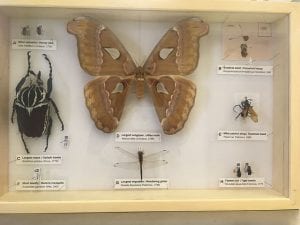The Frost Entomological Museum was selected to exhibit some of the collection in ‘Eclectic Collections’ at the HUB Robeson Center on Penn State’s University Park Campus. Hopefully, we can draw Penn State students, staff, and visitors to our exhibit while it is up through January. Since our current museum space is open by appointment only, we felt this was an excellent opportunity to still showcase the insects in our collection!

Our exhibit, titled Insect Superlatives, features extremes in entomology. The following is the information about the specimens in the exhibit:
Insect Superlatives, Curated by Emily L. Sandall, Frost Entomological Museum at Penn State
Comprising an estimated 6 million species, the insects are the most diverse group of animals on the planet1. Entomologists can study insect diversity using museum specimens to examine patterns in space, time, and appearance. Penn State is home to one of these collections, the Frost Entomological Museum, which houses insects collected in Pennsylvania and beyond over the last 150 years. Of all the diversity of the insects, here are some who represent extremes in entomology.
A. Most valuable | Honey bee | Apis mellifera Linnaeus, 1758
Pollinators, such as the honey bee, provide annual global food production services that value between $235 and $577 billion6. A number of factors, including climate change and insecticides have been linked to pollinator loss over the last decade.
B. Smallest | Parasitoid wasp | Dicopomorpha echmepterygis Mockford, 1997
This wasp would like dust on this paper triangle, at around 140 µm in length9; we show the photo of this microscopic wasp instead of an insect specimen. Parasitoid wasps lay their eggs in or on other insects and arthropod hosts to develop as larvae, emerge as adults, and repeat the process.
C. Largest mass | Goliath beetle | Goliathus goliatus (Drury, 1770)
At a maximum weight of around 100 grams, this beetle species, native to Africa, is considered to have the largest mass of the insects.
D. Largest wingspan | Atlas moth | Attacus atlas (Linnaeus, 1758)
The atlas moth has a wingspan of up to 27 cm and lives throughout Asia5. Only the caterpillar stage feeds; adult atlas moths live off of the energy stores of their youth.
E. Most painful sting | Tarantula hawk | Pepsis sp. Fabricius, 1804
The tarantula hawk is a wasp that stings its spider prey in order to use it as a host for its larva. Justin Schmidt, a Penn State alum who created a sting pain index described it as ‘instantaneous, electrifying, and totally debilitating’ for humans, warranting its second place ranking on his index8.
F. Most deadly | Malaria mosquito | Anopheles gambiae Giles, 1902
Female Anopheles can transmit the malaria parasite, causing an estimated 200 million cases of malaria each year between 91 countries2.
G. Longest migration | Wandering glider | Pantala flavescens (Fabricius, 1798)
The wandering glider, the longest-migrating insect, is a dragonfly that migrates an estimated 14,000-18,000 kilometers across the Indian Ocean3.
H. Fastest | Tiger beetle | Cicindela sexguttata Fabricius, 1775
Tiger beetles are among the fastest recorded insects, running at a speed of over 50 body lengths per second, 50x faster than the fastest human sprinters7.
1Stork, N. E. (2018). How many species of insects and other terrestrial arthropods are there on Earth?. Annual review of entomology, 63, 31-45,.
2World malaria report 2017. Geneva: World Health Organization; 2017. Licence: CC BY-NC-SA 3.0 IGO.
3Troast D, Suhling F, Jinguji H, Sahlén G, Ware J (2016) A Global Population Genetic Study of Pantala flavescens. PLOS ONE 11(3): e0148949.https://doi.org/10.1371/journal.pone.0148949
4Forbes, A. A., Bagley, R. K., Beer, M. A., Hippee, A. C., & Widmayer, H. A. (2018). Quantifying the unquantifiable: why Hymenoptera—not Coleoptera—is the most speciose animal order. bioRxiv, 274431.,
5Pavid, K. (2016). Spotlight: the atlas moth. The Natural History Museum. http://www.nhm.ac.uk/discover/spotlight-the-atlas-moth.html, 6Pollinators vital to our food supply under threat. Food and Agriculture Organization of the United Nations. http://www.fao.org/news/story/en/item/384726/icode/,
7Gilbert, C. (1997). Visual control of cursorial prey pursuit by tiger beetles (Cicindelidae). Journal of Comparative Physiology A, 181(3), 217-230.,
8Schmidt, J. O. 1990. Hymenoptera venoms: striving toward the ultimate defense against vertebrates, pp. 387-419. In D. L. Evans and J. O. Schmidt [Eds.], Insect defenses: adaptive mechanisms and strategies of prey and predators. State University of New York Press. 9Jerry E. Gahlhoff, Jr. (1998) University of Florida Book of Insect Records Smallest Adult Jerry E. Gahlhoff, Jr. Chapter 38 Smallest Adult. http://entnemdept.ufl.edu/walker/ufbir/chapters/chapter_38.shtml#mockford_1997
Leave a Reply